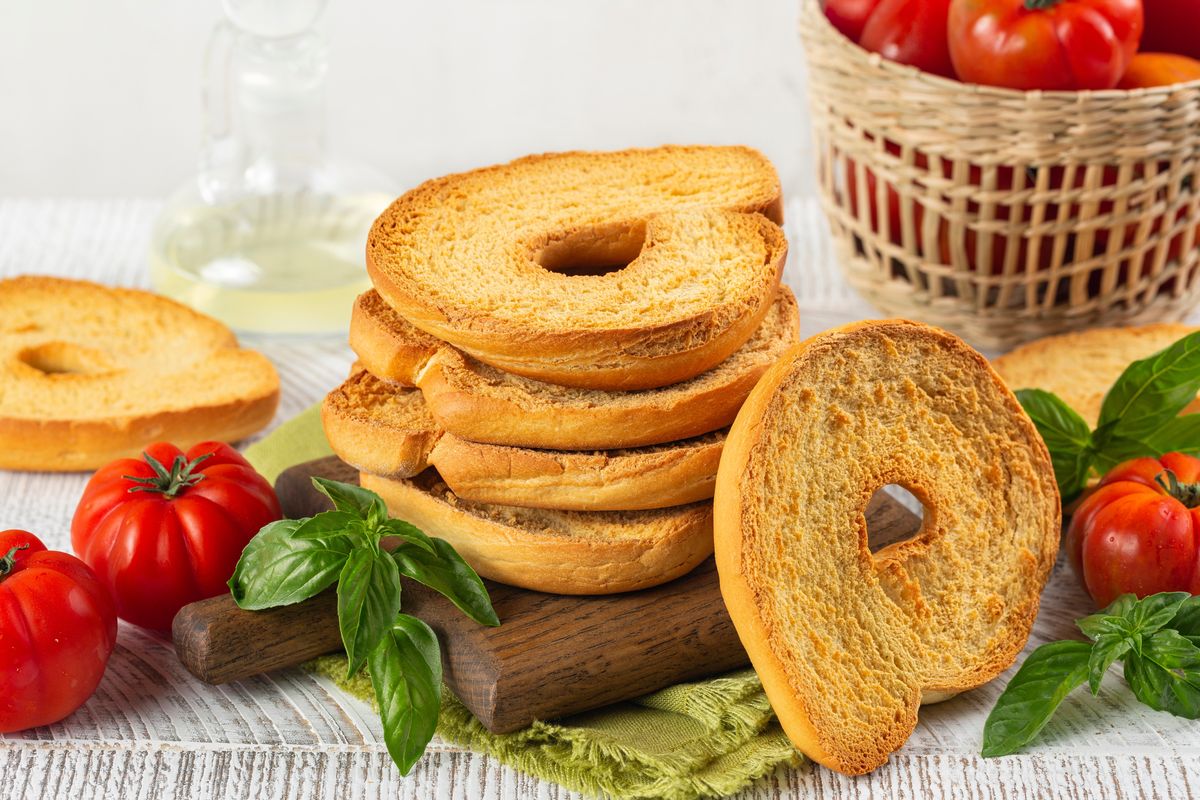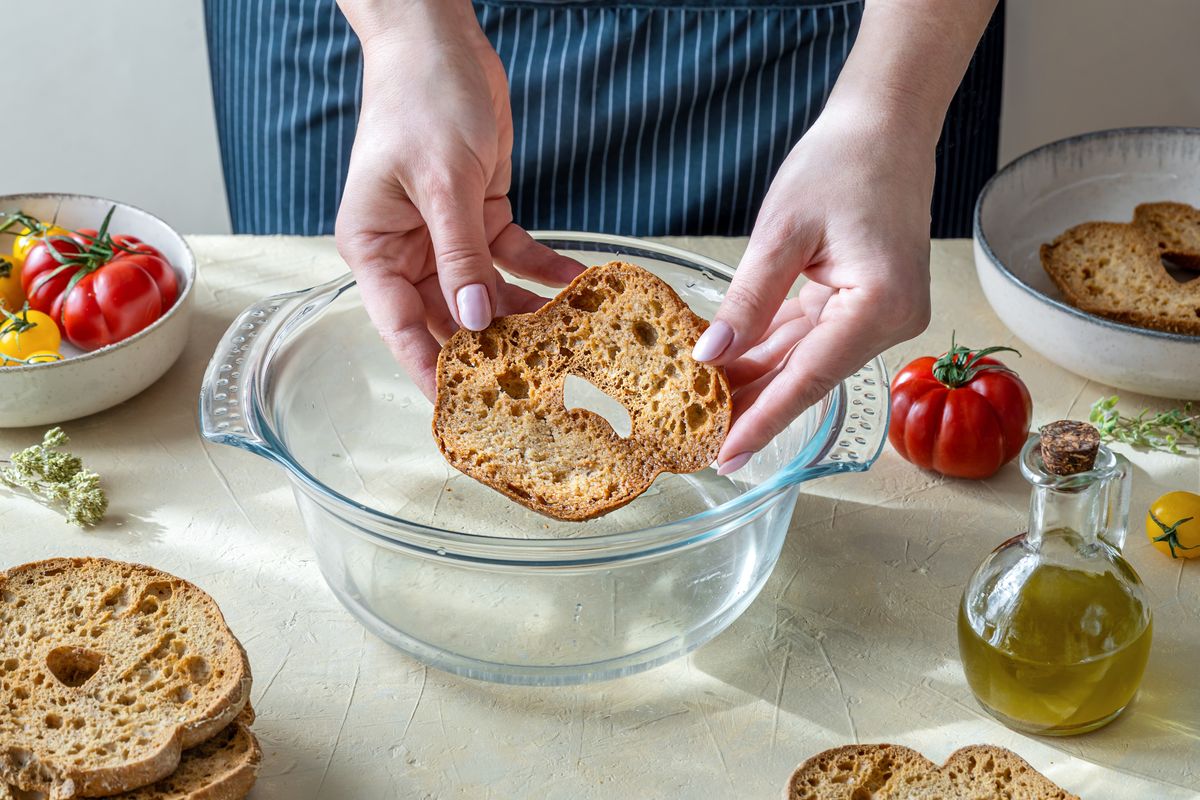Recipes
Homemade friselle


Let's find out how to prepare homemade friselle, wet them and season them just as the Apulian tradition dictates.
Typical of Puglia but widespread throughout the south, friselle also known as Fresèdde (Barese), fresèlla (Foggiano), frasèdda , frisèdda and frisa (Salento), frisoccula (Cellino San Marco) , are a sort of dry bread with a characteristic hole central. They boast a thousand-year history and are still the undisputed protagonists of summer aperitifs and lunches today.
Preparing them at home from scratch is very simple and is ideal if you want to recreate the flavor of tomato friselle enjoyed on holiday at home.
To obtain the right degree of crunchiness, the frisella must be cooked twice : the first is quicker while the second is slower and serves to biscuit them, i.e. make them crunchy and let out all the moisture. So let's see all the steps to prepare them but above all how to season the friselle to perfection.

How to prepare Apulian friselle with the original recipe
- This dough is really very simple to make by hand, just like housewives used to make. Combine the two flours in a bowl and give a quick mix.
- Dissolve the yeast in the water and pour it onto the flour little by little, mixing with a spoon. When the mixture begins to take consistency, add the salt .
- The last ingredient to incorporate is the oil . Spread the dough slightly, add it then close it and knead so that it is absorbed.
- Finish working it on the pastry board until it is smooth and homogeneous, then leave it to rise for 2 hours in the bowl, covered with cling film and then with a cloth.
- Divide it into 6 loaves and give it a rounded shape using the pirlatura technique.
- At this point it is necessary to give the frisa its characteristic appearance and form the hole . Insert two fingers (index and middle) in the center and slightly widen the dough, then also insert the two fingers of the other hand and rotate them to widen it. It must be quite large (4-5 cm) because it tends to shrink during cooking.
- As they are ready, place them well apart so that they must not touch each other, on a baking tray lined with baking paper and leave to rise for another 30 minutes .
- The time has come to cook them. As mentioned, the first cooking will be at a high temperature and for a short period: 200°C for 10-12 minutes.
- Remove from the oven and use a serrated knife to cut the friselle in half while they are still hot. Put them back in the oven and cook them at 170°C for 30-40 minutes or until they are dry.
- Let them cool completely before storing or seasoning them.
Preparing the friselle is really very simple but we still leave you a video where you can observe the most critical steps of the recipe, i.e. giving the shape and obtaining the right degree of crunchiness.

How do you get the friselle wet?
In order to be consumed, the friselle must be soaked in water or stripped . Perhaps this step is even more complex than the preparation of the frisella itself because only a few seconds separate you from a shapeless mush to a bread as hard as marble.
To wet the friselle you can follow two paths: the first consists of passing them directly under the jet of water , while the second is the one we recommend if you are a beginner. Fill a glass or plastic container large enough to accommodate one frisella at a time with water at room temperature. Add a spoonful of oil, a pinch of salt and dip the friselle one at a time, cut side down.
Dip them for 2-3 seconds then lift them out. Repeat the step 3 times until no more air bubbles come out of the frise. At this point they are ready to be seasoned. In Puglia there is also a special dish with a perforated lid called sponza frise : a must have for fans of this recipe!
Friselle: how to season them
We start from the assumption that, like any bruschetta, frize can also be seasoned according to your tastes . The most famous condiment is undoubtedly the tomato one: pure and simple goodness.
If, however, you wish to experiment with richer and tastier combinations then you can add finely sliced onion and tuna or mozzarella , again in chunks, to the cherry tomatoes. Also excellent with a sort of salad of cherry tomatoes, tuna, capers and olives . To make the frisella even tastier, before seasoning it, rub some garlic on the surface. In summary, here's how to season the friselle, from the most classic to the most "exotic":
- cherry tomatoes, oil, garlic, salt (possibly basil or oregano);
- cherry tomatoes, tuna, onion, oil, salt;
- cherry tomatoes, mozzarella, oil, salt;
- cherry tomatoes, tuna, olives, capers;
- grilled vegetables;
- hummus and grilled vegetables
storage
The friselle can be stored for over 6 months in a paper bag.
Origin and history of friselle
As mentioned in the introduction, friselle boast a thousand-year history . In fact, already in the 10th century, the Phoenicians used to bring dried bread, the ancestor of frisella, with them on long sea voyages, which they then soaked in sea water, a bit like the biscuits of the Ligurian sailor . Another name by which frize are known is crusader bread . These, together with an apple and a handful of dried chestnuts, represented the breakfast or snack of the soldiers heading to the Holy Land.
In all cases, friselle were created to preserve bread for long periods , as well as a providential supply in case of famine. Furthermore, they had a longer baking interval than traditional bread, which allowed the time between one oven switching on and another to be extended.
To understand this aspect we must place ourselves in a historical context that is very different from the current one: bread was a valuable product and we did not always have the flour to prepare and bake it. For frizes the situation is the same. Consider that although durum wheat ones are the most widespread today, they were once reserved for the nobility. Everyone else prepared them with barley .
But why do friselle have a hole ? Once again it is the practical sense of the population that takes over. The hole in the center of the friselle was used to insert a rope and thus create crowns that were convenient to keep hanging. As regards the origin of the name, Pliny the Elder in Naturalis Historia suggests a link between the term frendere , i.e. to grind, cut into pieces, and fresella .
Since 2001, frisella has been a Traditional Agri-Food Product ( PAT ) and during the summer there are various events in which it is the protagonist: in July, Putignano (BA) hosts the Frisella Festival, in August it is the turn of the Marittima Frisella Festival ( LE), of the “ ta friseddhra e tu pimmitoru sprintrisciatu ” festival in Supersano (LE), and of the Frisella Fest in Ceglie Messapica (BR).
Riproduzione riservata © - WT











